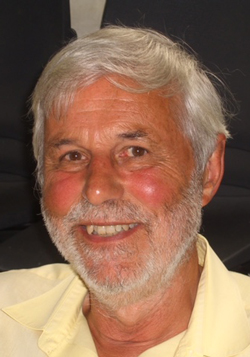Outstanding field geologist who focussed on Precambrian petrology, structural geology, and stratigraphy

Alan Wright’s love of fieldwork was stimulated by a British Exploring Society expedition to Iceland. He graduated from the University of Birmingham in 1953, two years ahead of his future wife, Margaret, who was also a star student. Alan’s PhD focussed on the influence of particle size and shape on magnetic remanence, supervised by Don Griffiths and Roy King. Alan used novel electron shadowing techniques and displayed a flair for experimental work and physical analysis. Following completion of his PhD in 1956, he joined the Overseas Geological Survey, part of the British Geological Survey, in Tanganyika (now Tanzania) in 1957. Here he mapped structurally complex terrain, co-authored a monograph on the Uluguru Highlands, and developed a focus on anorthosites, which he later also studied in the Lewisian complex and in Greenland. Returning to the UK, Alan first took up a position at the University of Glasgow where he initiated a long-term collaboration with Don Bowes. In 1962, he returned to the University of Birmingham, where he eventually retired as Senior Lecturer.
Left: Alan Edward Wright. Image courtesy of Ian Fairchild.
Fieldwork
Between 1967 and 1971, Alan led three expeditions around the fjord country of Angmagssalik (now Tasiilaq), East Greenland, as well as various Precambrian locations in the UK, Ireland, and Scandinavia. He took his young family on fieldwork in Greenland and Finland, which they remember as very positive experiences.
Publications
Alan’s work with Bowes on appinites, explosion breccias, and volcanogenic breccias attracted much attention and they were involved in many published discussions with prominent petrologists. Meanwhile, he produced the definitive treatment of the Dalradian stratigraphy and structure of the Appin area and later supervised other Appin Group doctorates, with a particularly novel development of chemostratigraphic approaches with Arthur Hickman.
Alan joined colleague, George Bennison, in authoring the popular student textbook
The Geological History of the British Isles (1969), in which he wrote the comprehensive Precambrian chapter. Alan’s wide knowledge of Precambrian and Caledonian geology in the British Isles led him to publish overview papers and, in 1976, a hypothesis in
Nature about the alternating polarity of Precambrian and Palaeozoic subduction. Alan presented his work widely internationally.
Librettist
Alan had a gentle nature and was a marvellous colleague. He had a lively, albeit understated, wit which brightened up many an undergraduate petrology practical class. As an undergraduate he penned librettos for operatic performances, featuring lampoons of the staff and their activities. In 1955, a graptolitic verse requiring a rhyme with “family” ended with “with a granny knot for its mother in the sheepshankograptidae”. Conversely, in the 1980s, he was delighted to be on the receiving end during student Christmas revues. Before retiring in 1993, Alan saw through to graduation the last cohort of University of Birmingham students who entered before Aston University merged. Alan and Margaret were hospitable in retirement, latterly in Ashbourne where they attended the Methodist Church, and he kept in touch with many former students. He is survived by Margaret and their daughters, Ann and Clarysly.
By Ian Fairchild